The Lost and The Damned
› Game Rules and Backgrounds
›
HeroQuest, Advanced HeroQuest & Warhammer Quest
Diagonal movement in HeroQuest (and other games)
Diagonal movement in HeroQuest (and other games)
|
Administrator
|
As anyone who's read the rules will know in HeroQuest you cannot move diagonally (many other games also share this rule for the sake of simplicity) so when confronted with diagonal corridors like these from Billiam Babble's excellent Dungeon Floorplans what do you do?
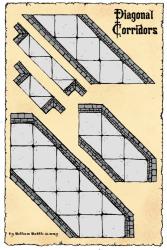 One solution of course is to ignore the rules and allow diagonal movement as a house-rule, but you'll quickly find this leads to players using diagonals to skip quickly across rooms, avoid taking their jump-test to clear pit traps and many disagreements about moving diagonally past monsters, walls and so on. So then you have to come up with a bunch of 'diagonal blocking' rules like these from Mighty Warriors 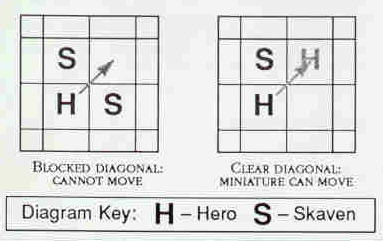 or the equivalent ones from WHQ, CaStLe RaVenLoFt and other games which allow diagonal movement. You might also need to come up with a rule meaning that diagonal movement costs double (which certain players will conveniently forget to gain an advantage in combat). Anyway you'll quickly find that what at first seemed like the simplest solution quickly becomes rather complicated 
 Well here's my alternative solution: allow models to move through but not finish their movement in the 'half squares' created by the diagonal walls. Basically treat the 'half squares' like a square occupied by a friendly model. This means models can zig-zag their way along diagonally corridors. Well here's my alternative solution: allow models to move through but not finish their movement in the 'half squares' created by the diagonal walls. Basically treat the 'half squares' like a square occupied by a friendly model. This means models can zig-zag their way along diagonally corridors.
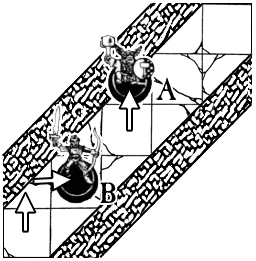 A: Incorrect Movement! the Dwarf cannot finish his movement in the 'half square' created by the diagonal wall
|
|
Would move B take up one movement point or two?
|
Re: Diagonal movement in HeroQuest (and other games)
|
Administrator
|
B (the legal move) would be 2 movement points, hence the 2 arrows (it's a rather cut down example)
-----------------------------------
~The ravings of a single mad Goblin is bad enough, but such a power-hungry, malice-filled creature as Mortis can never hope to be understood~ |
Re: Diagonal movement in HeroQuest (and other games)
|
for simplicity sake I think the best system is just to allow diagional movement at the regular 1 movement cost. the perfect squares are tough to justify movement by the corners touching, it doesn't make sense logically. it makes more sense to visualize little circles in the center of each square that the character stands on. its also easier to get the feel with circular bases.
|
Re: Diagonal movement in HeroQuest (and other games)
|
after thinking about the dribble I just posted, I did some math. the perfect correct answer is 1.5 movement per diagional on squares. and keep the rule that 2 adjacent monsters block the diagional. its a little more complicated, but the GM is suppose to be vigilant against abuse, right? right?
|
Totally agree, both for movement and blocking monsters. I usually use this system. This is the AD&D 3.x method, that is to say: "The even diagonal squares count as two squares" (so the counting of the squares in diagonal movement is: 1, 2-3, 4, 5-6, 7...).
+ Other planes lie beyond the reach Of normal sense and common roads But they are no less real Than what we see or touch or feel. +
|
Re: Diagonal movement in HeroQuest (and other games)
|
Administrator
|
This post was updated on .
In reply to this post by hydrosqueegee
Here are 2 move examples show the huge difference abuse of diagonal movement can make
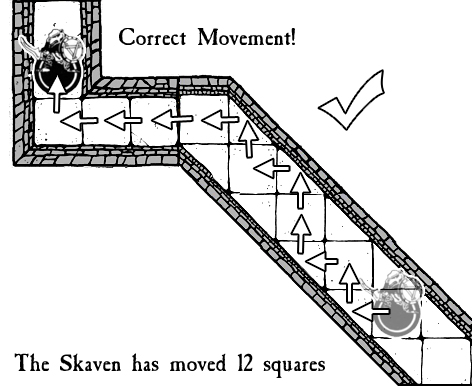 ^Legal Movement: the Skaven moves in much the same way has he could in open space 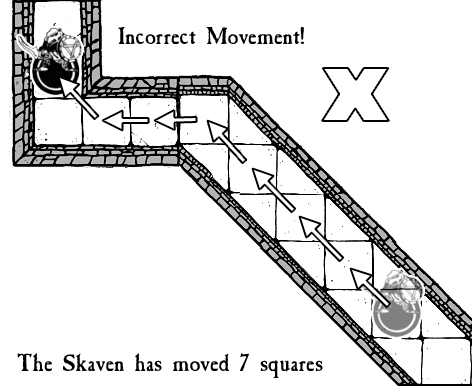 ^Illegal Movement: the Skaven uses much less movement (note how the Skaven is able to 'skip' round the 90` corner too) the 1.5 movement rate for diagonals is another good idea but it does add extra maths to the game and still of course requires horrible diagonal blocking rules - my rules are all about keeping it simple and playable
-----------------------------------
~The ravings of a single mad Goblin is bad enough, but such a power-hungry, malice-filled creature as Mortis can never hope to be understood~ |
|
I guess that the Machomer one is not too bad... I mean, the 1st diagonal is at 1 mov, the second at 2... then again 1 in case of a 3rd mov.... should not be too complicated.
I will try that when I will have another chance of playing :) |
Re: Diagonal movement in HeroQuest (and other games)
|
Administrator
|
on paper (or the screen in this case) it is simple, but I find it's very easy too loose count of odd and even squares of movement during a game - my method leaves no room for doubt
-----------------------------------
~The ravings of a single mad Goblin is bad enough, but such a power-hungry, malice-filled creature as Mortis can never hope to be understood~ |
Re: Diagonal movement in HeroQuest (and other games)
|
Administrator
|
In reply to this post by Marchomer
Actually there is still a bit of a difference, here's a round up of all the methods mentioned so far 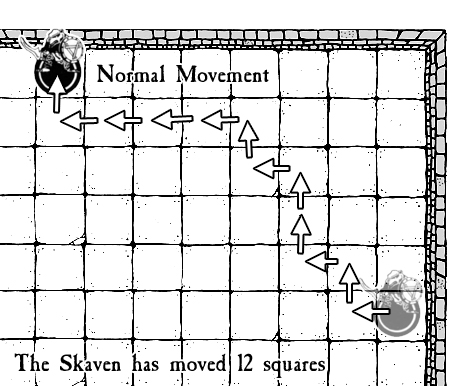 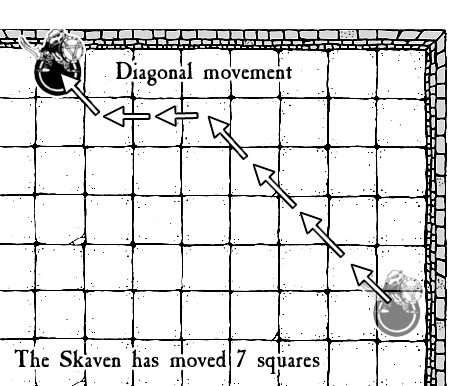 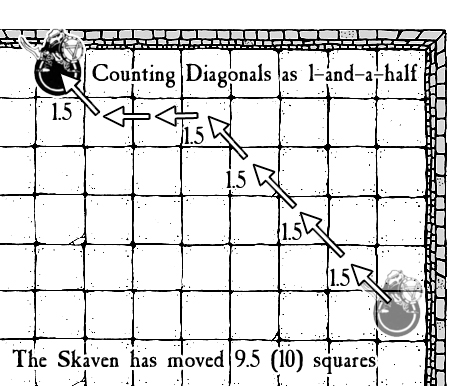 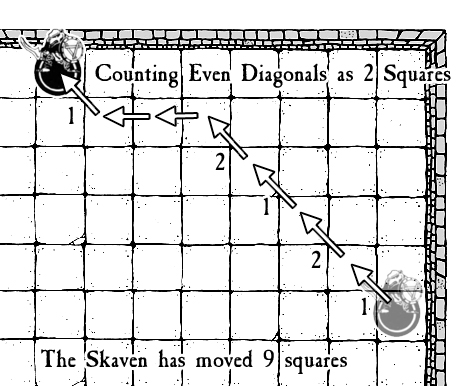 IMHO diagonal movement causes too much confusion and leaves room for cheating personally my vigilance in this case takes the form of not allowing diagonal movement in my games 
-----------------------------------
~The ravings of a single mad Goblin is bad enough, but such a power-hungry, malice-filled creature as Mortis can never hope to be understood~ |
Re: Diagonal movement in HeroQuest (and other games)
|
if characters can move at 1.5 per diagional, of course they're going to move further with less movement than limiting to pure ajacent moves. if you compare the distance in a pure centimeter measurment, it works just fine. it takes a meandering 12cm path with ajacent moves to get to the target square in your example. in the 1.5 diagional example you move 9.5cm in a more direct path.
so diagionals allow a more natural path for characters to follow. the only simple rule is to allow ajacent movement only. for a little added realism and a smidge more complexity, diagional at 1.5 or the 1, 2&3 rule works nicely. I must admit I have never run a game with diagional movement, but I will use the 1.5 when I do. |
|
In reply to this post by MortiS-the-Lost
As I already said on Facebook, Mortis, you're right, the 1,5 counting doesn't work in the same way of the AD&D 3.x system (the even-odd system).
Absolutely, the "Normal Movement" is the neatest one, the "Diagonal Movement" is the worst one... too unbalanced, the "D&D system" is more accurate than the others but as you said it could generate confusion. Anyway I still prefer the D&D system (even if not the neatest one), because this system guarantees a good accuracy. Let me explain why with an example: If there was two Skaven in the room moving in two different directions, one of them in diagonal (Bishop) and the other one in straight line (Rook), without the D&D system the distance covered by the two Skavens, will results different. Using the "Diagonal Movement", the Bishop Skaven will be too fast, and using the "Normal Movement" too slow.
+ Other planes lie beyond the reach Of normal sense and common roads But they are no less real Than what we see or touch or feel. +
|
|
In reply to this post by MortiS-the-Lost
This is exactly what I used for the Sewers questbook, except for the not allowing them to stop in half a wall, but that is actually a very good idea. I'm going to use this! That way, it's basically still moving in straight lines, and not diagonally, so it can't be abused.
Eager HeroQuest newbie since july 2011 :D
Check my Custom EU format card sets! Ye Olde Inn | HeroQuest blog with lots of usefull stuff |
|
Interesting thread. What about Into The Sewers, many of the passages are made up with "half squares". We use two "halves" to make one "full"
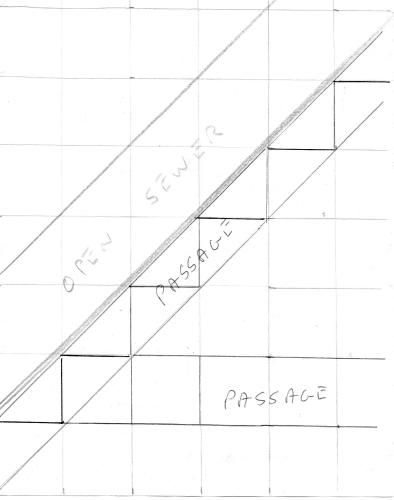
Be sure your sins will find you out.
|
Re: Diagonal movement in HeroQuest (and other games)
|
Administrator
|
For the narrow diagonal paths by the sewer channels I use the following rules: Models can move through but cannot finish their moment in a square that is part wall and part floor, however models can finish their movement in a square that is part water and part floor and are still considered to be standing on the path and not in the water. 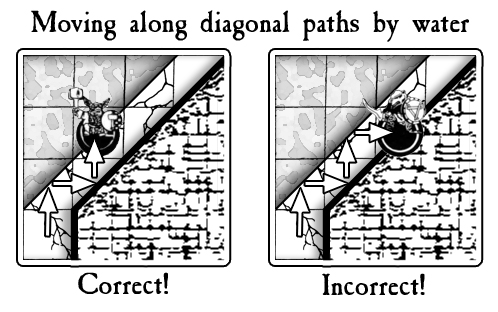 ^the Dwarf may finish his movement in the 'half square' created by the water (because the water doesn't 'occupy' the square). The Skaven cannot finish his movement in the 'half square' created by the diagonal wall (darn cheating Skaven!  ) )
Sjeng; feel free to use the diagram above in your quest book
-----------------------------------
~The ravings of a single mad Goblin is bad enough, but such a power-hungry, malice-filled creature as Mortis can never hope to be understood~ |
Arrrr, just posted the quest book... Don't think there's room for it though, I packed it pretty tightly. But perhaps if I ever update the quest, I'll add them ;) Thanks!
Eager HeroQuest newbie since july 2011 :D
Check my Custom EU format card sets! Ye Olde Inn | HeroQuest blog with lots of usefull stuff |
|
In reply to this post by MortiS-the-Lost
I only use water to clean my teeth, or with Scotch. Never learnt to swim, too late now! We will have to agree to differ on this one.
Be sure your sins will find you out.
|
|
In reply to this post by MortiS-the-Lost
I used to play Chainmail d20 all the time and never really found the evens-counts-as-2 system to be hard or complicated and it seemed the most fair. The 1.5 system also works pretty well. Diagonals counting the same (as it does now in D&D 4e) seems to allow movement to be far too quick on diagonals and diagonals not being allowed seems to make the movement diagonally be far too slow. That's my opinion at least.
For Heroquest, I would say that both diagonal squares being blocked prevents movement (as in Mortis's pic), and I would personally use the 1.5 system. It is the easiest and basically works out to every other one counting as two but it is the odd ones counting as 2. What I wonder about with the corridors is how heroes can fight in the corridor if noone can end up in the half-squares. Unless you have a staff or longsword, you can't attack diagonally. |
Re: Diagonal movement in HeroQuest (and other games)
|
Administrator
|
Ah, now that was a slight over site on my part due to having a huge system of house rules - under the 'MortiS Quest' system any weapon can attack diagonally us long as there is nothing in the adjacent squares either side of the diagonal. Long Staffs, Spears, Halberds and other Pole-arms (reach 1 weapons) break this rule however and may attack past occupied squares on a diagonal or 1 square away 'through' a square occupied by a friendly model (pikes use the same rules but have a reach of 2 square and cannot be used inside dungeons). These rules were adapted from the late 2nd edition AD&D 'Combat and Tactics' book.
-----------------------------------
~The ravings of a single mad Goblin is bad enough, but such a power-hungry, malice-filled creature as Mortis can never hope to be understood~ |
Re: Diagonal movement in HeroQuest (and other games)
|
In reply to this post by MortiS-the-Lost
I must say that I'm particularly enjoying all of these b/w graphics you guys are mocking up.
  Diagonals with walls are a devil to cut and paste with. Diagonals with walls are a devil to cut and paste with.
This certainly beats some of my own solutions where triangle squares are filled with impassable rubble (WoC DnD plans are also guilty of this). I'm going to get a bit abstract here (and off the point), thinking in general terms for RPGs ... It's a curious problem. In my head I think of corridors that are one square wide (on the diagonal of the square) as really 1 and a half squares across (not exactly, but hey). (EDIT: I think I'm echoing Nuadha here ?) In meta-game terms one square is a suitable fighting space for one character to fight from. Two characters in the same party fighting side by side on two triangular half squares may have to be limited or penalised in their actions because they are squeezed against each other in a 1 1/2 squares space. Does that make sense? Both warriors will have 25% less space each to fight in (wall-to-wall). A small movement/action penalty is a great idea (it's a sort of one-and-a-half step - a long stride). A psuedo game-world explanation could be that basic weapon training drills with striking and blocking taught in a traditional way which means that everyone with martial skills only move at right angles with a wide stance. Only the foolhardy risk a diagonal step! :D Naturally nimble elves and halflings are immune to the restrictions. Of course the other solution is to use the angled "knee-joint" links ... but lets face it, the diagonal corridors here work with existing grids, battlemats and graph paper. (Apologies for obvious repetitions) |
«
Return to HeroQuest, Advanced HeroQuest & Warhammer Quest
|
1 view|%1 views
| Free forum by Nabble | Edit this page |


